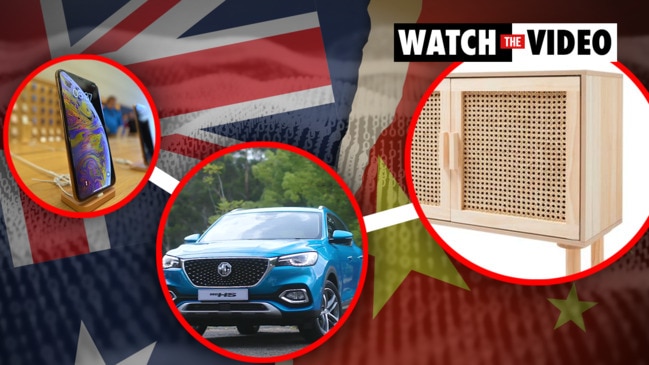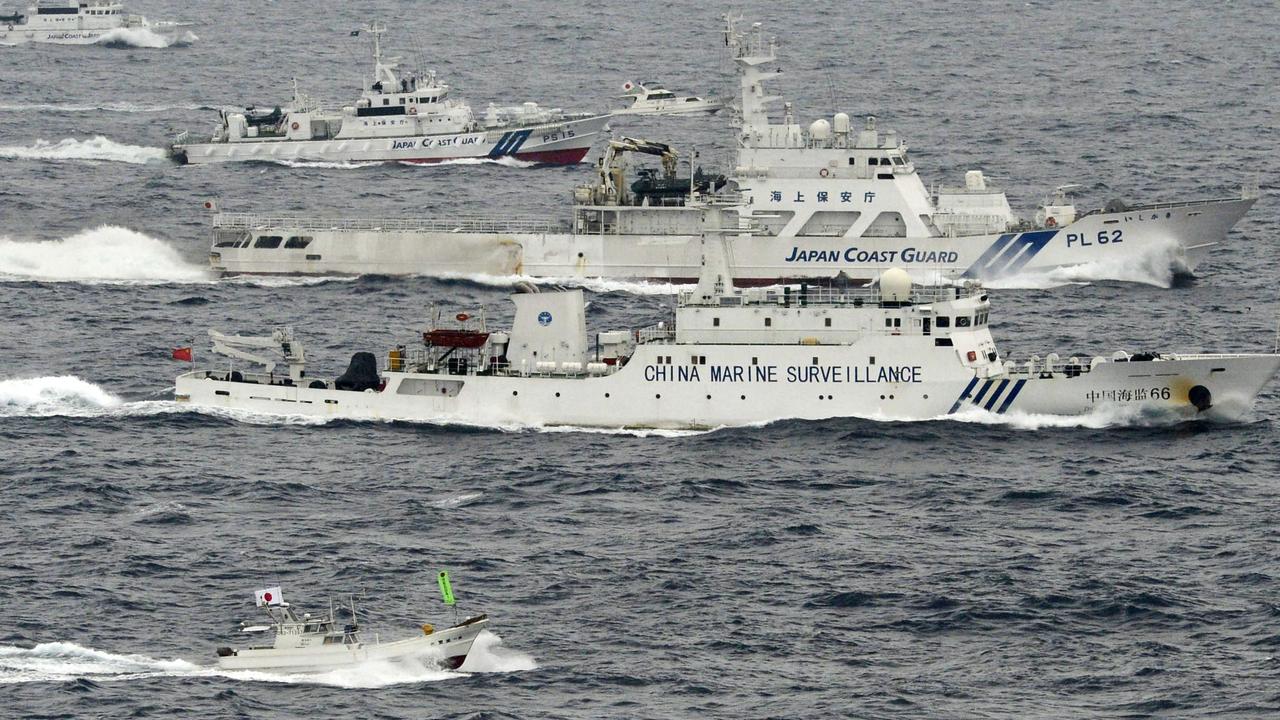Bitter dispute sees US-Japan navy play war games against China’s Coast Guard
A bitter dispute in the East China Sea has boiled over into a war game, the likes of which hasn’t been seen since World War II.

China’s Coast Guard has been elbowing its way around some remote Japanese islands all year. Now a large-scale US-Japan naval exercise is practising how to seize them back.
Tens of thousands of US and Japanese troops are engaging in an island-hopping campaign not seen since World War II.
It’s part of exercise Keen Sword 21. Its mission is “to deliver combat troops to defend the Senkakus or respond to other crises or contingencies”.
The Senkaku Islands are a group of uninhabited rocks some 1900km southwest of Tokyo, just a few hundred kilometres from Taiwan.
They’re at the heart of a bitter dispute with Beijing.
Imperial Japan surveyed and claimed the islands in 1895. Communist China laid claim to them in 1952. Since July, Chinese navy-controlled Coast Guard vessels have been relentlessly plying their waters as though they are in control.
RELATED: China’s aggression backfires

RELATED: Tiny island China desperately wants
Now Tokyo is pushing back.
“The security situation around Japan has become increasingly severe,” the chief of Japan’s defence force, General Koji Yamazaki, told media aboard the Kaga helicopter carrier on Monday. “This gives us the opportunity to demonstrate the strength of the Japan-US alliance.”
On 26 Oct, JSDF and US Forces kicked off Japan-US Bilateral Joint Exercise “ #KeenSword 21". In launching exercise, GEN Yamazaki, Chief of Staff, Japan Joint Staff, and LtGen Schneider, Commander, US Forces Japan, hold a bilateral press conference on JS KAGA. #USJapanAlliance pic.twitter.com/MkOj0UHUWk
— Japan Joint Staff (@JapanJointStaff) October 27, 2020
The USS Ronald Reagan Carrier Strike Group is contributing to the 20 warships, 170 aircraft massing in the area. Some 46,000 troops will be participating in the war game operating out of Okinawa and mainland Japan.
“Our arrival today was simply to demonstrate the ability to move a few people, but the same capability could be used to deploy combat troops to defend the Senkaku Islands or respond to other crises and contingencies,” said US commander Lieutenant General Kevin Schneider.
TREATY TRIGGER
Ownership of the Senkaku Islands is complicated.
Imperial Japan claimed the uninhabited outcrops after surveying the region during its 1890s war with Imperial China. The islands were occupied by the United States after World War II but returned to Tokyo’s control in 1972.
In 1952, Communist China declared it owned the islands as a legacy of its centuries-old Imperial empire. It’s the same basis of claim Beijing asserts over the entirety of the South China Sea. An international court of arbitration rejected this in a 2016 ruling as historically baseless.
Beijing has rejected the ruling.
This has profound implications as the US-Japan mutual defence treaty commits Washington to defend the disputed islands as though they were US territory.
RELATED: ‘Prepare for war’: China hits back
Keen Sword is the first major military exercise with Japan since Yoshihide Suga took over the role of Prime Minister of Japan last month. He’s vowed to counter China’s pressure on Japan’s territories.
For his part, General Schneider, the US force commander in Japan, says Washington is “100 per cent absolutely steadfast in its commitment to help” defend Japan’s ownership of the Senkakus.
SHARPENED SWORDS
Marines swam ashore to scout the islands. Follow-up forces were then inserted by tilt-rotor MV-22 Ospreys. Watching protectively over all was a fleet of AH-1Z Viper attack helicopters.
“Our ability to rapidly seize and operate from critical maritime terrain will support naval operations to ensure we are ready to fulfil our treaty obligations to Japan and maintain a free and open Indo-Pacific,” a US navy statement declares.
Exercise Keen Sword forces “will train in a comprehensive scenario designed to exercise the critical capabilities required to support the defence of Japan and respond to a crisis or contingency in the Indo-Pacific region,” adds General Schneider.
This includes mixing and matching the use of helicopters, fighters and personnel of different nations among the multinational force.
“Demonstrating interoperability between the two forces in realistic scenarios is as important, if not more so, than displaying any shiny new hardware,” says Kanagawa University international relations analyst Corey Wallace.
Offload!#Marines with 3rd Low Altitude Air Defense Battalion (LAAD) disembark from a CH-53E from Marine Heavy Helicopter Squadron 361 (HMH-361) prior to conducting ground threat reaction training in Okinawa, Japan. #FreeAndOpenIndoPacific pic.twitter.com/vxFBysEa5g
— 1st MAW Marines (@1stMAW_Marines) October 27, 2020
The joint US-Canadian-Japanese exercise is due to end on November 5.
‘COERCIVE AND UNILATERAL’
Japan’s biggest warship, the helicopter carrier Kaga, is soon to be rebuilt to operate F-35B “Jump Jets” to enhance its combat capability. But the 248m long vessel is currently leading the international force in the simulated island-hopping campaign.
Its refit – and that of its sister ships – represents Tokyo’s growing concerns at Beijing’s ambitions.
Japan’s defence white paper, also released in July, warned of a surge in China’s “coercive and unilateral actions”. That same month the US signed a deal allowing Japan to purchase 105 F-35B jump-jets as part of a $US23 billion ($A32 billion) package that will eventually deliver a total of 147 stealth fighters.

Mr Suga this month visited Vietnam and Indonesia to strengthen Japan’s ties with its South East Asian neighbours. He’s also hosted talks aimed at reinforcing the informal “Quad” relationship between Japan, the US, Australia and India.
FOOD FIGHT
Even as the combined US, Japanese and Canadian naval fleet plies the disputed waters, China’s fishing militia is accused of pushing Tokyo’s boats out of their own exclusive economic zone.
The chase for diminishing flying squid stocks has seen the Communist Party-controlled fleet push its way into North Korean waters. It is allegedly behind the deaths of North Korean crews and a spate of so-called “ghost ships” washed up on the shores of Japan.
Now the Chinese ships are moving on to the Japanese side of the Sea of Japan. So far, Tokyo’s Fishery Agency has warned some 2600 Chinese vessels they are breaching its territory – four times more than last year.
Japan has imposed a ban on its own fishing fleet operating in the Yamatotai area to preserve squid stocks.
Jamie Seidel is a freelance writer | @JamieSeidel




